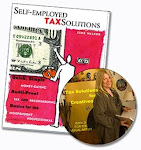June --
I'm from Sandpoint, Idaho and am a Textile Artist. I had my first sales last year.
I am having a hard time finding info as it relates directly to artists. I've poured over IRS Publications and am still unclear as to: Inventories: The pieces of art I sold were made by me prior to becoming a business. How do I put a cost basis value on them? Are the materials that go into the pieces of art (primarily fabric and thread) considered inventory (as in raw materials) or supplies?
Is there a specific place I can go to find out more specific info for my profession?
Sheila
Dear Sheila,
Your cost of the art sold is your cost of the materials that went into making them before you became a business. What you have on hand and not yet sold is called inventory. There is no deduction for inventory. The deductible expense is cost-of-goods-sold.
Cost-of-goods-sold may be figured in several ways and the explanation is too lengthy for a blog post. Your tax pro would use the method most suitable for your situation.
There is a chapter in my book, Self-employed Tax Solutions , about just your kind of situation. I have included an excerpt below.
From Personal To Business Use
Many independent professionals migrate to self-employment from the joys of hobbyland or from work as an employee. Caitlin Caterer came to her profession when her kids entered school and by turning her joy of cooking for friends into a profitable business. Eddie Electronic went from selling himself short while working for someone else to selling his service for himself and keeping all the profit.
Both these indies started their sole proprietorships with equipment and supplies that they had purchased for private use. Caitlin had a significant culinary library that she began accumulating before she went into the catering business. Eddie had more electronic testing equipment and software than many who had been in business for years. Both Caitlin and Eddie used these things in their new business venture. And they could write off the costs of their personal-to-business-use equipment and supplies. Here’s how: They need to look at their things as they would were they buying it used from a thrift shop or on the web for example. If Eddie, over the years, paid thousands of dollars for his equipment and software but could now sell it all at a flea market for $900, then he treats these items as a $900 purchase for his business. If Caitlin, over the years, paid $2,000 for her book collection but now, because many of the books are out of print, could sell her culinary library online for $2,800. she would get a library deduction for her new business in the amount of $2,000. Why less than it’s worth? Because you get, as a deduction, the lower of your cost or fair market value at the time it went into use in your business.
In Self-employed Tax Solutions there is an EQUIPMENT WORKSHEET that will aid in calculating your deduction. My book is also the place to get that specific info you need about a self-employed artist.
Best,
June
Subscribe to:
Post Comments (Atom)





No comments:
Post a Comment